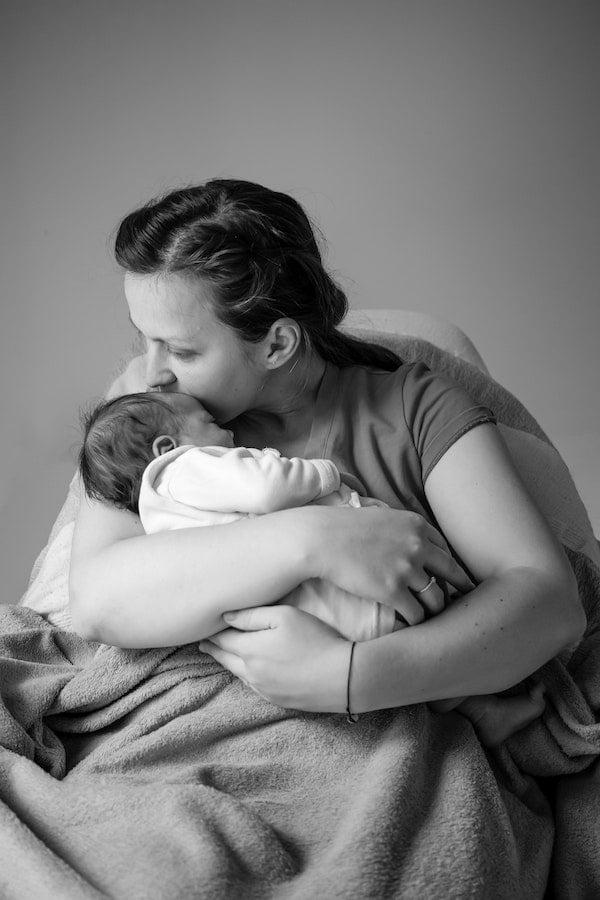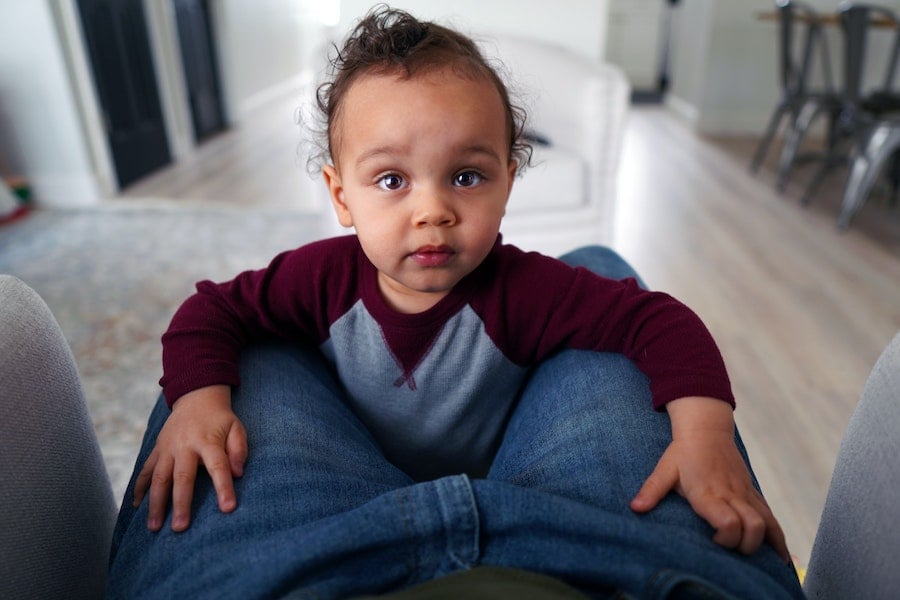There’s nothing more frustrating than baby sleep regressions. Just yesterday you were bragging to your friends about what a great sleeper you have, and now, much to your horror, they are no longer “sleeping like a baby”.
Come to think of it, this has happened before… around 6-8 weeks, 3 months, oh ya- the scarring 4 month sleep regression, then again at 10 months, 15 months, and now 24 months. “Will it ever end”, you ask?! Ummm not when you add teething and illness on top of it!
But the good news is that I have 3 strategies for you to survive each of these regressions and get your baby back to sleeping like a baby. Until they start teething. Or get sick. Or you’re traveling. Or they turn 13 and want to stay up all night…. never mind.
Before we dive into surviving the awful sleep regressions, let’s talk about when sleep regressions can happen! Sleep regressions typically happen around the following ages:
- Around 6-8 weeks old
- 3 months old (crap naps)
- 4 months old (often the most difficult)
- 6 months old
- 8 months old
- 10 months old
- 12 months old
- 15 months old
- 24 months old
Don’t freak out yet, you can (and will) survive all of them! Let’s talk about how!
1. Key to Surviving Sleep Regressions – Prevent Overtiredness

When your baby is an itty bitty newborn they are super sleepy and it’s not hard for them to fall asleep whenever, wherever. Then, when they are about 6-8 weeks old, suddenly there is a very rude awakening (pun definitely intended).
It takes actual work to get your baby to sleep as they try to fight off sleep in order to take in more of their new surroundings. Now they are overtired, and getting them to sleep is even harder.
To prevent this horrifying cycle from occurring, start paying attention to the clock and watch closely for sleepy cues. Try not to let your baby stay awake for longer than 60-90 minutes except for the wake window before bed, which can be up to 2 hours. And remember, you can’t spoil a newborn! So do whatever you need to do to get your baby asleep on time.

This may mean rocking to sleep in a dark and quiet environment or if you are on the go, use a car seat cover and white noise machine. This strategy will also work for when you hit the 3 month sleep regression and suddenly your baby is the President and CEO of Crap Naps.
It can be so frustrating to work hard to get your baby to sleep, only to have them wake up 32 minutes later. Every. Single. Nap. If this is happening to your little one, the best thing you can do is try to rock or soothe them back to sleep. Helping your baby extend their naps and get the sleep they need, will set a foundation for good sleep and longer naps.
2. Sleep Training During Regressions

Luckily, you can still do sleep training during regressions! (PS- If you’re struggling with daycare sleep regressions head here!)
I’m sure you’ve heard war stories of the most infamous sleep regression of all time: the 4 month sleep regression. It’s a doozy. Or more accurately, a complete sh*t show.
It’s actually an amazing and exciting time, as your baby’s brain is changing and becoming capable of deeper sleep. However, this means nighttime and naps go up in flames.
The solution here is for your baby to learn the skills required to get into that deep restorative sleep and stay there. Enter, your knight in shining armor: sleep training.
As your little one is going through this 4 month sleep regression, it is the perfect time to teach them the skills to initiate sleep on their own. Once they can fall asleep on their own, they will then stay asleep longer and when they wake up after a sleep cycle, they will be able to put themselves back to sleep. (Check out our full article about 4 month old sleep schedules here.)
If you would like all the details on how to sleep train, I have modified CIO, modified modified CIO, and no-cry options, all in my Sleep Training Essentials video course and 4-24 months guide pack. Or better yet, join our virtual group sleep training as a participant or a spectator. It’s girl’s night/double date night with the spouses and SO much fun!
It is my mission to empower you to do what works best for you and your baby. You can get great sleep while preserving attachment, and I would love to show you how to do it!
3. Stay Consistent to Overcome Regressions
Like most things in life, consistency is half the battle when trying to survive sleep regressions!

The 10 month sleep regression is up next, and It’s when your baby starts trying to tell you they don’t need two naps anymore. DON’T LISTEN TO THEM! They are definitely trying to trick you.
Spoiler alert, this will happen again at 12 months. Until a baby is around 15 months old, they still require two naps a day. If the first nap is a crap nap, then get your baby up and continue on with your day (while you light a candle and mourn the loss of that hour to yourself). Then put them down for their usual afternoon nap. It’s so important to stay consistent and try not to let this overwhelm or frustrate you. If you stay the course and continue offering both naps, your baby will get back on track in no time!
At 12 months old, your baby is developing and learning so many new things! All this extra energy can result in your baby becoming overtired. Again, you want to stay consistent. Keep offering both naps, try and stay calm, and make sure you are fully stocked with coffee and wine.
Around 15 months, your baby will start right back up with protesting naps. However, this time they are not trying to trick you. It IS probably time to drop to one nap.
Dropping one nap can be a tricky process, however, I outline the process and everything you need to know in my 4-24 month guide pack and my 2-5 year guide pack. You should be prepared for it to take around a month for this transition to iron out. (As I said, make sure you are well stocked in the coffee and wine department). As you work through dropping to one nap, some days your baby will benefit from two naps and some days only one. That’s ok, and it will help your baby not become overtired!

The 24 month sleep regression is when your toddler’s imagination is really developing and FOMO is in fulllllll swing. They may start having general fears as well, thanks to that well oiled imagination. This can all contribute to your toddler trying to refuse their nap.
However, yet again, your child is trying to trick you. As strong-willed as they have become, and convincing as they are, they still need that nap. In fact, most children require a nap until 2.5-3 years old.
The best way to handle this is to stay consistent. Keep offering the nap and stick to your sleep routines. Now, as we both know, you (much to your dismay) cannot MAKE your child sleep. So instead, you want to set clear boundaries around what nap time looks like.
For example, I take a firm but gentle approach that nap time is one hour, in your room, door closed, and quiet time. Even if your child doesn’t fall asleep, this “quiet time” is beneficial and restorative. (Although let’s be real, we’re crossing our fingers they just fall asleep). Toddlers can be super tricky, so check out my 2-5 year guide pack for all the tips and tricks for toddler power struggles, separation anxiety, nightmares, fears, getting out of bed, transitioning to a big kid’s bed, and more!
Final Thoughts on Surviving Baby Sleep Regressions

Lastly, you may find it fun to know that sleep regressions can happen at any time, not just the “common times” outlined above. (Again, let’s circle back to that coffee and wine.)
Remember, to make it through a sleep regression you should…
- Prevent overtiredness
- Stick to sleep training basics
- Stay consistent and stick to a schedule
However, all my tips apply to any sleep repression. For everything you need to know about sleep regressions, check out my Sleep Regression troubleshooting guide, which you can find in my 4-24 month guide pack and my 2-5 year guide pack.
Best of luck surviving baby’s next sleep regression, you’ve got this!
Additional Sleep Regression Resources by Age
Looking for age-specific or problem-specific regression help? Here are some other helpful articles!


